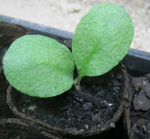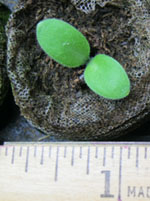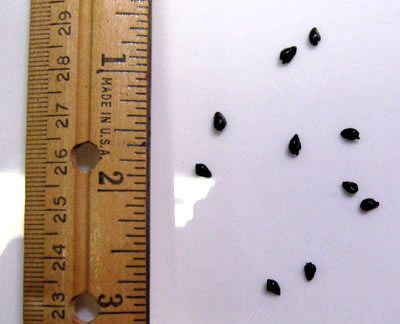
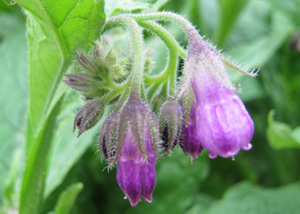
|
Organic
True / Common Comfrey Seeds
True or Common
Comfrey (Symphytum officinale) is the first comfrey. It is heirloom and
open pollinated. It has been used medicinally for thousands of years by
many different cultures.
The seeds reproduce true (the seedling is just like it's parents). Some
types of comfrey such as Russian Comfrey are a hybrid so the seeds are sterile
(will not grow). All types of comfrey can be propagated by root cuttings.
True Comfrey has different varieties with flower colors of yellow, pink,
red (bright pink), or purple. It grows to about 3 feet tall including the
flower stalk. It is smaller than Russian comfrey.
For more about True
Comfrey.
|
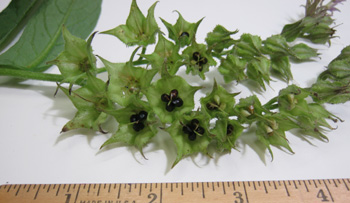
|
Common
Comfrey Seed with Purple Flowers
Above and
below are photos of True Comfrey seeds. True Comfrey with purple flowers
is Symphytum officinale var patens.
The seeds are organic, open pollinated, not GMO, and not treated with chemicals.
The plants like full sun in well drained soil. They can tolerate partial
shade. They prefer a loam soil but sandy is OK if it is kept moist. Sow
the seeds 1/8 inch deep and 1 inch apart. Pat the soil around it lightly.
Keep the soil damp but not wet. Germination takes 10-30 days.
To the upper left is a photo of the comfrey seeds on the flowerstalk. Below
are True Comfrey seedlings.
|
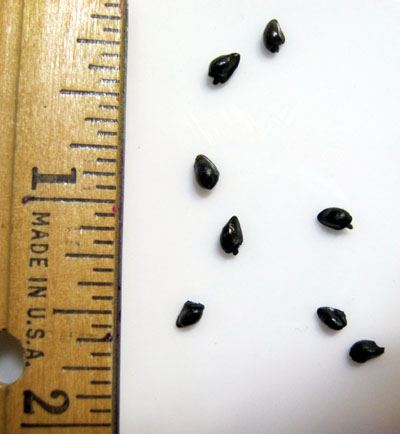 |
How
to Improve Germination with Stratifying
The best way to get Common/True Comfrey seeds to germinate is to stratify
them. Stratification is a cold and moist period of one to several months.
It mimics the conditions of winter in northern climates.
Put your seeds in moist sand, vermiculite, coir, potting soil, soil-less
potting mix, or paper towel. Then put in a baggie, cloth bag, or glass jar
with lid. (A paper towel is the least preferred medium because it is sterile
and does not contain endogenous growth hormones that encourage germination.
Peat moss alone is too acidic.)
Kelp (seaweed) has naturally occurring growth hormones that help seeds germinate.
Add a little kelp to the germination medium. It is also good for seedlings
too to prevent damping off.
|
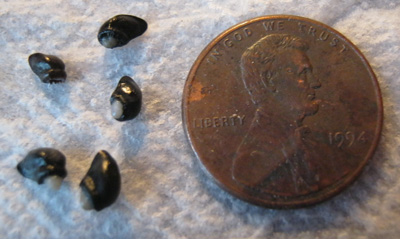 |
Refrigerator
is Winter for Seeds
Put the bag or jar in your refrigerator. Do not put them in your freezer
when moist. Keep there for 30-60 days with 30 days probably being the best.
This breaks the dormancy of the seeds.
This photo is True/Common Comfrey seeds that have been stratified in a damp
paper towel in a refrigerator for 1 month. You can see the little white
buds starting to form. They are viable (will grow).
|
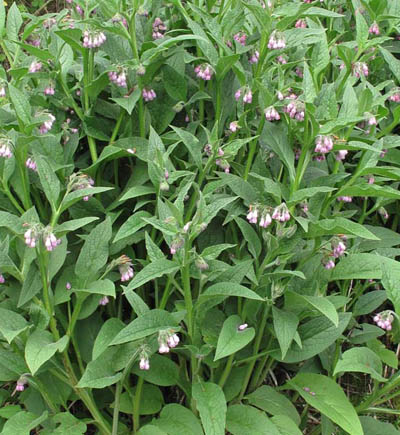 |
Plant
Comfrey in Greenhouse or Outside
Then plant
outside if soil temperature is between 68-80 degrees. Germination is better
when first planted in a warm greenhouse or sunny house window.
Try to keep soil temperature between 68-80 degrees Fahrenheit. You can use
a horticulture heat pad under a seed tray to do this. You can even use a
poultry incubator if it has a clear top. Adjust thermostat for 70 to 80
degrees.
With these warm methods the seeds germinate in 10-15 days.
"The True
Comfrey seeds I ordered from you in the spring came up fine, and the plants
are doing great." -Jim, Stamping Ground, Kentucky
|
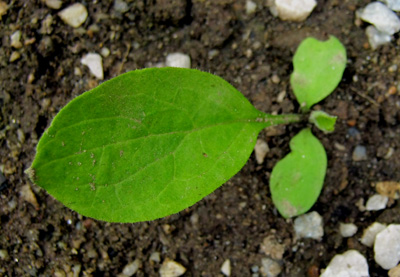 |
Young
Comfrey Seedling
After the
True Comfrey seedlings have been growing in the greenhouse for a few months,
gradually harden them to cooler temperatures before planting outside. Plant
at least 2 weeks after the last frost date in spring.
Plant seedlings about 8 inches apart. You transplant again when they get
bigger to about 2 feet apart in all directions.
|
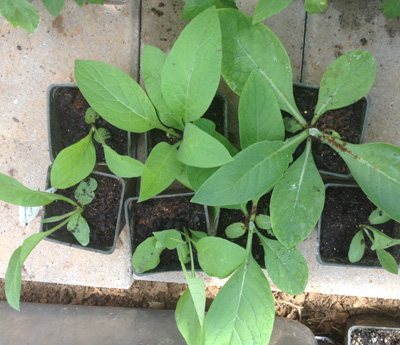 |
6-Week
Old Seedlings
This photo
is True Comfrey grown from seed I sent to Maggie in Crumpler, North Carolina.
The pots are 3 x 3 inches. The plants are 6 weeks old.
On February 26 Maggie sowed her seed directly into organic seed starter
soil in an unheated greenhouse. The soil was moist but not soaking. She
did not stratify them first. She had a very good germination rate.
When they were a few inches tall with their true leaves, she put them in
3-inch pots. She makes her own potting soil using 1/3 vermiculite, 1/3 compost,
and 1/3 coir. Peat moss can be used instead of coir. She put a teaspoon
of kelp in each pot.
|
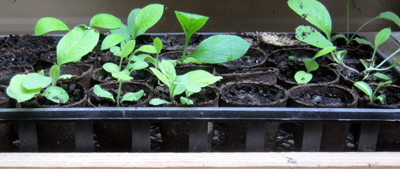
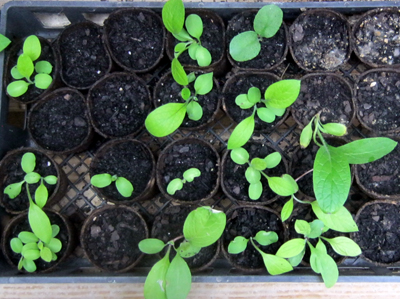 |
True
Comfrey Seed Experiment
I did a seed germination experiment by stratifying some seeds in the fridge,
and not stratifying some seeds. I used different stratifying mediums (moist
vermiculite only, kelp only, paper towel only).
Also soaking some seeds for 24-48 hours with no stratifying, and then planting
them. Also directly planting them into peat pots as shown in the photo.
There were some differences, and I need to do more testing to verify the
results. My overall conclusion is be patient. Some seeds come up in only
10 days. At 2 1/2 months I still have seeds sprouting.
Speed of germination depends a lot on the soil temperature.
|
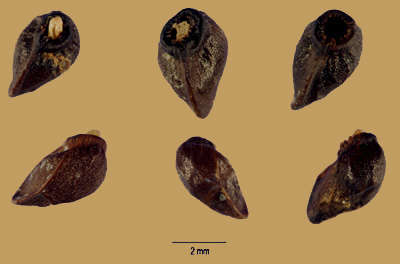 |
Planting
Outside with No Stratifying
You can plant the seeds directly outdoors with no stratifying but the germination
rates are less.
Plant outdoors after the last expected frost in spring. It is best if soil
temperature is between 68 and 80 degrees F but should be above 40 degrees.
These take about 20 to 30 days to germinate.
The text at the bottom of this photo says 2 mm (millimeters). 2 mm
= 5/64 inch.
|
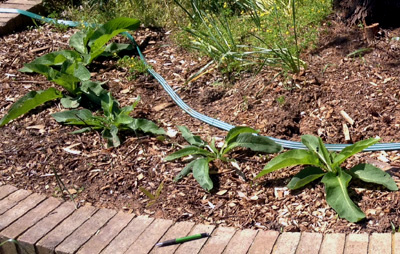 |
Comfrey
Plants Grown from Seeds
Here is a
photo by Misti in South Carolina. These are her True Comfrey plants from
seed she bought from Nantahala Farm and Garden.
The seeds were sown in August. The photo is the next May (9 months later).
|
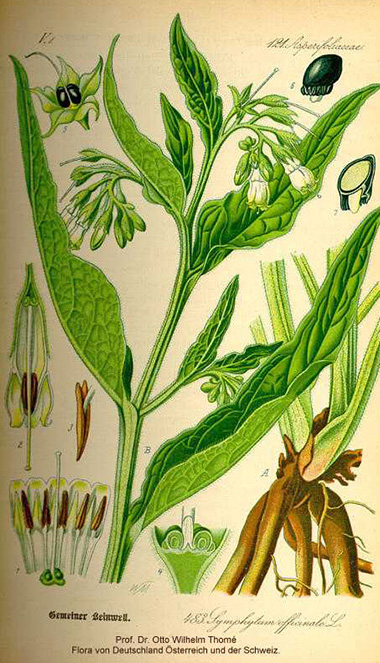 |
Growing
True Comfrey Seeds
You can let
the plants flower and grow to seed so they spread. Or you can cut off the
flower stalks before they go to seed if you do not want them to spread.
This drawing of Symphytum officinale is by Professor Doctor Otto Wilhelm
Thome from Germany. He was a botanist and botanical artist. He lived from
1840 to 1925.
"My mom
planted all the comfrey seeds. She was happy to find you had the comfrey...that
it was good for everything and the garden stores don't carry it anymore-
because it works." -Amanda, New York
"Two Comfrey
seeds sprouted after a few weeks. Then I just left the seed tray sitting
(and watered it occasionally) while I was watching my 2 plants develop and
waiting to plant them in the yard. Long after I thought there was any chance
of more plants – 5 more of the seeds sprouted. I planted the seeds in April,
and some of them sprouted in June – amazing!" -Melonie, Rosman, North
Carolina
|



